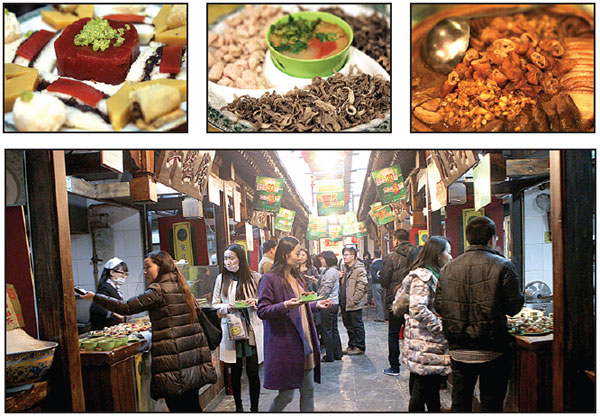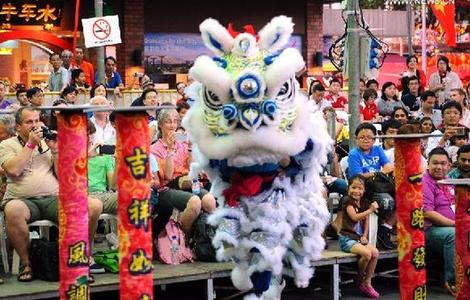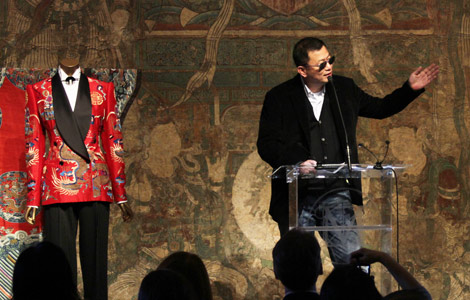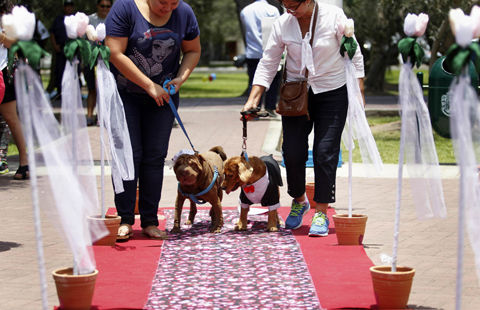Savoring old Beijing at Nine Gates Snack Restaurant
Updated: 2015-02-19 07:59
By Zhuan Ti(China Daily)
|
||||||||
|
Three of the traditional Beijing dishes available during the “snack exploration tour of Shishahai” at the restaurant which has been adapted from a courtyard house. Zou Hong / China Daily |
Chinese festivals are always linked with food. As Spring Festival approaches, Beijing's festive food culture is on full display everywhere, both in people's homes and in restaurants.
On Feb 6, the Beijing Tourism Development Commission announced the start of an event it calls the "snacks exploration tour in Shishahai" at the Nine Gates Snack Restaurant, or Jiumen Xiaochi, to enable people to savor the traditional Beijing fare.
Since 2009, the commission has held a series of food promotion campaigns to boost tourism during Spring Festival by building a brand called "Eat in Beijing". Local snacks, or xiaochi, are an important part of the annual Spring Festival food promotion campaign.
As one of the three major snack traditions in China, Beijing fare is among the top food options for visitors to the Chinese capital. The Nine Gates Snack Restaurant, which opened in 2006, is seen as the best place to taste authentic Beijing snacks. Most of its chefs are descended from families that kept the authentic recipes alive for more than 100 years.
About 30 people were invited for a free snack dinner on Feb 6, and during the Spring Festival, the restaurant will offer discounts to all diners.
Located in a hutong along the north bank of Houhai Lake, the restaurant was adapted from a courtyard house of nearly 3,000 square meters.
It offers about 200 kinds of snacks to diners. Apart from a few foods originating in other places in China, most of the items are famous Beijing snacks such as douzhi, a favorite drink of old Beijingers made from mashed soybeans, baodu, or quick-boiled tripe, rice cakes and almond soup.
The restaurant got its name from the nine gates in the wall that used to surround Beijing. Its name bears the connotation of a place where all the capital city's snacks can be found, according to Yang Tieliang, a consultant to the restaurant.
"Beijing snacks used to be sold at stalls on the street. But they distinguish themselves from snacks in other places in China because they have diverse ethnic origins such as the Mongolian, Manchu and Hui cultures, and many are derived from imperial foods," Yang said.
"Beijing snacks have a history dating back to the Yuan Dynasty (1271-1368), when in its early days chefs often learned other food styles before forming the final recipes, which makes the food popular among people from all walks of life."
Nearly 15 vendors operate in the Nine Gates Snack Restaurant as co-partners, selling freshly made foods from small stalls. Customers can eat at tables in a public area or in separate dining rooms.
It is easy to find an elderly person at a stall making the food or instructing others how to do it. They are the inheritors of Beijing brands - about 12 vendors have a brand name that dates back to Qing Dynasty (1644-1911).
Li Yue, about 50 years old, is the inheritor of the Chatang Li brand founded in 1858.
Chatang, or fried flour tea, is essentially fried flour. Made with hot water and different seasoning, such as sweet-scented osmanthus, and sugar, chatang makes a delicious bowl of soup. The fried flour can be substituted with water chestnut powder or lotus root powder.
Li said he pays great attention to quality, noting all the ingredients Changyang Li uses are sourced from special providers.
Apart from a stall in Nine Gates, Li also owns a restaurant selling chatang and other Beijing food in the Hepingli area not far from Yonghe Lama Temple.
Li learned to make chatang from his father in the early 1980s. He still follows the family's secret recipe, but has made innovations to present the traditional flavor in a modern way.
The teapots used to boil water must be of brass to make the traditional flavor, but the tables and chairs don't necessarily need to be all made of wood, Li said.
The decoration and service need to meet with modern customer's requirements, not the other way around, Li noted.
He also hires waitresses who are able to communicate with foreign customers in English, Li said.
Just like chatang, many other traditional snacks served at Nine Gates have interesting names.
Ludagun, or donkey rollover, is a glutinous yellow rice cake roll with fried bean flour sprayed onto the surface.
Wandouhuang, or pea yellow, is a mashed pea cake made from boiled and mashed peas and small Chinese jujubes.
Many local Beijingers come to the restaurant when they want to enjoy time with their families, especially senior members, said Li.
zhuanti@chinadaily.com.cn
(China Daily USA 02/19/2015 page11)
Most Viewed
Editor's Picks

|

|

|

|

|

|
Today's Top News
Upbeat on US-China relations
Beijing-San Jose nonstop planned
Wealth of China's super rich to rise in Year of Goat
Empire State Building turns colors of national flags
Chinese man compensated for 8 years wrongful custody
Metropolitan Museum of Art to focus on China
Reward raised for clues to Chinese family's slaying
New visa policy draws more Chinese tourists
US Weekly

|

|

















